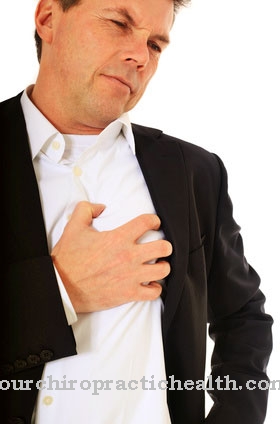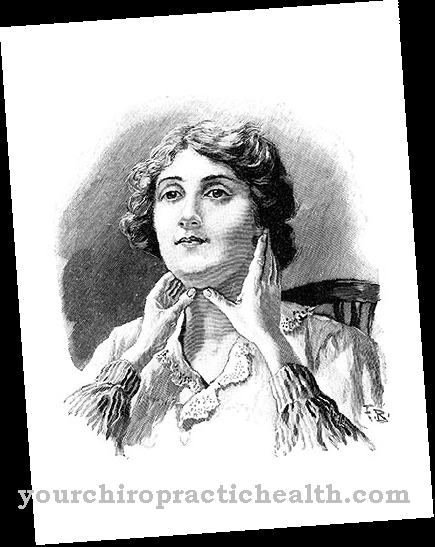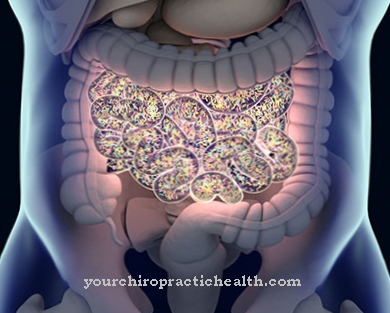The Duchenne muscular dystrophy is a malignant muscle disease that is due to a genetic defect on the X chromosome, so the disease can only occur in male offspring. The symptoms show up as early as infancy in the form of weaknesses in the pelvic and thigh muscles. It always ends fatally in early adulthood due to the breakdown of the heart and lung muscles.
What is Duchenne muscular dystrophy?
.jpg)
© Sebastian Kaulitzki - stock.adobe.com
As Duchenne muscular dystrophy (DMD) is a progressive muscle weakness that is based on a genetic defect on the “male” X chromosome. Because the genetic defect is on the X chromosome, the disease can only occur in male family members.
For these, however, it is inherited, because the gene on whose mutation the disease is based only occurs once and cannot be balanced by a second gene - as is usually the case with a diploid set of chromosomes. This means that if the genetic defect is present, male offspring will definitely develop DMD.
DMD manifests itself at an early age between the first and sixth years of age as a result of muscle weakness and muscle breakdown in the pelvic and leg muscles. The disease itself is triggered by a synthesis disorder of the protein dystrophin. Dystrophin is an important and functionally necessary component of the membrane that surrounds the muscle fibers (sarcolemma). DMD is the most common form of all known muscular dystrophies.
causes
The so-called DMD gene, which is responsible for coding the protein dystrophin, is located on the X chromosome. With 2.5 million base pairs, it is the largest known gene in the human genome and is therefore susceptible to mutations, which usually completely prevent the synthesis of dystrophin.
The mutation of the DMD gene can be the loss (deletion) of a part (several base pairs), a duplication or a point mutation in which only a single nucleobase is affected. The mutations trigger various forms of muscle weakness, of which Duchenne muscular dystrophy is by far the most common manifestation.
It is noteworthy that in about a third of boys with DMD, the disease was caused by a new mutation and not inherited from the mother. This explains why DMD does not decrease significantly in the frequency of its occurrence.
Symptoms, ailments & signs
Duchenne muscular dystrophy (DMD) manifests itself in the first years of life and begins in the pelvic girdle area. The toddlers have problems walking, run unsteadily, trip and fall more frequently. You are unable to run fast. Furthermore, due to the weakened thigh muscles, they cannot straighten up on their own, but support themselves with their hands on the thighs when straightening up.
This characteristic symptom is also known as Gower's sign. People with Duchenne muscular dystrophy (DMD) show an increase in connective and adipose tissue, especially in the calf area. Therefore their calves appear unusually strong.
In medical terminology, the thickened calves are called Gnomwaden. In addition, patients with Duchenne muscular dystrophy (DMD) have pointed feet and a pronounced curvature of the spine in the lumbar region.
Duchenne muscular dystrophy (DMD) progresses rapidly, so that the majority of patients are dependent on wheelchairs and all-day care before the age of 12. In the advanced stages of the disease, weak breathing muscles can lead to breathing difficulties. In addition, those affected have decreased reflexes and suffer from sensitivity disorders. Around a third of the patients also have an intellectual disability.
Diagnosis & course of disease
If the initial suspicion is confirmed, neurological examinations and functional tests of the muscles are indicated. Imaging methods such as MRI and ultrasound can also provide further information. An increased level of the muscle enzyme creatine kinase can often be found in the blood. Ultimate certainty is provided by genetic diagnosis that also allows the muscular dystrophy to be assigned to one of the known manifestations.
The course of DMD is progressive. From the 5th to the 7thAt the age of 16, those affected can usually no longer get up from sitting or lying down without outside help and can no longer climb stairs. The muscle wasting leads to deformation of the joints and the accumulation of fat tissue in the muscles to replace the muscle tissue. As a rule, children aged 10 to 12 are dependent on a wheelchair. Life expectancy is around 40 years, although an earlier death before the onset of puberty cannot always be prevented.
Complications
As a rule, Duchenne muscular dystrophy causes death of the patient. Death occurs at a very young age. Above all, parents and relatives are affected by severe psychological complaints and moods. Due to the disease itself, the patients suffer from severely weakened muscles.
This weakening takes place throughout the body, so that internal organs and the heart are also weakened. Eventually cardiac death occurs. Ordinary activities are also difficult for the person concerned to carry out and the patients suffer from a very low level of resilience. It is not uncommon for the patients to be dependent on the help of other people in everyday life.
Joints and muscles are often deformed and the Duchenne muscular dystrophy severely restricts movement. This disease can also lead to psychological complaints and thus significantly reduce the patient's quality of life. Treatment of Duchenne muscular dystrophy is not possible.
Those affected are dependent on various therapies in order to increase life expectancy, which is, however, greatly reduced. However, there are no particular complications in the treatment.
When should you go to the doctor?
A doctor should be consulted in the event of muscle strength disorders, reduced physical performance or muscle tension. If there are already irregularities in the development and growth process in direct comparison to peers, a visit to the doctor is advisable. Consultation with a doctor is recommended if the patient is poorly resilient or tired quickly. Deformation of the body structure, incorrect posture of the upper body or a general incorrect load on the skeletal system must be examined and treated. Curvature of the spine is characteristic of Duchenne muscular dystrophy and should be discussed with a doctor immediately.
A doctor is required in the event of breathing disorders, breathlessness or interruptions in breathing. Immediate action is required in the event of acute respiratory impairment or oxygen deficiency. Indications for this are a blue discoloration of the lips and fingers, loss of consciousness and an inner weakness. In severe cases, an emergency service must be alerted. Until the patient arrives, they need mouth-to-mouth resuscitation. If the person concerned suffers from sensory or perceptual disorders of the skin, this is a sign of an existing irregularity. It should be clarified so that treatment can alleviate the symptoms. A visit to the doctor is advisable in the event of abnormal intellectual potential, an alleged intellectual disability or learning disabilities.
Treatment & Therapy
To date, AMD is not curable. All attempts at gene therapy have so far been unsuccessful and probably failed due to the body's own immune system. For some years now, drugs have been under development or even already undergoing experimental testing that are intended to mitigate the effects of the genetic defect on dystrophin synthesis so that the body can synthesize dystrophin again - at least to a limited extent.
One drug that is currently in clinical trials is Eteplirsen, also known as AVI-4658. Another drug in the experimental phase is ataluren. In the presence of so-called nonsense mutations, which lead to the abortion of the transcription of the base sequences due to so-called stop codons, Ataluren should be able to prevent the abortion of the transcription. If successful, this means that the body would be able to synthesize dystrophin again, thereby halting muscular dystrophy.
The therapies currently used are aimed at alleviating the symptoms and also include life-prolonging measures, but do not have any influence on the actual cause of the disease. The catalog of measures for combating symptoms consists of a mix of medical care, physical and occupational therapy as well as care and psychological support for the patients and their relatives. As the disease progresses, breathing aids over oxygen masks are necessary. In later phases, an incision in the windpipe (tracheotomy) is usually necessary in order to be able to carry out active ventilation.
You can find your medication here
➔ Medicines for muscle weaknessOutlook & forecast
A cure for Duchenne muscular dystrophy is not yet possible today. The disease is characterized by a characteristic course and usually has the same prognosis for all those affected. Between around three and five years of age, slight muscle weaknesses become noticeable in the legs. Subsequently, the thigh and pelvic muscles continue to shrink, and connective and fat tissue replace the gradually shrinking muscle tissue. Later, the muscles of the shoulders and arms are also affected by muscular dystrophy.
Between the ages of five and seven, the affected children are dependent on constant help to get up from lying or sitting. Many of the affected children with Duchenne muscular dystrophy lose their ability to walk completely by the time they are twelve, which means that they can no longer do without a wheelchair. In the further course of the disease, those affected can initially still care for themselves, but to a limited extent. Most of the time, however, patients are then dependent on full care from family members from the age of 18.
Ultimately, Duchenne muscular dystrophy also affects the respiratory muscles and the heart muscle of those affected, which reduces their life expectancy. As the disease progresses, it almost always leads to death from suffocation or heart failure.
prevention
Since muscular dystrophy AMD is caused by a genetic defect, no direct preventive measures that could protect against the onset of the disease are known. An early diagnosis, if possible in the 1st or 2nd year of life, helps, however, to combat the symptoms through a wide range of therapeutic measures and to delay them. In addition to nourishing and supplying the body with minerals, amino acids, vitamins, enzymes and trace elements, targeted physiotherapy is important in order to maintain muscle functions for as long as possible.
Aftercare
In the case of Duchenne muscular dystrophy, the options for direct follow-up care are usually significantly limited or, in some cases, are even not available to the patient. For this reason, the person concerned should ideally consult a doctor at an early stage in order to avoid the occurrence of other complaints or complications.
Self-healing cannot occur, so a visit to a doctor is usually necessary. Most patients are dependent on the help and care of their own families in everyday life. In doing so, those affected must be relieved, whereby exertion or stressful and physical activities should generally be avoided.
Psychological support is often also important in order to prevent depression and other psychological upsets from occurring. Furthermore, in the case of Duchenne muscular dystrophy, physiotherapy measures are necessary to alleviate and limit the symptoms. Many of the exercises can also be repeated at home to further alleviate the symptoms.
Further follow-up measures are usually not available to those affected with this disease. The Duchenne muscular dystrophy may also reduce the patient's life expectancy.
You can do that yourself
Aids are very important for anyone living with Duchenne muscular dystrophy. They increase the quality of life, make everyday life easier and support participation in society. It is therefore all the more important to be well informed about which aids are suitable and which options of care are available. In the late ambulatory and in the non-ambulatory phase, additional aids may be required to cope with everyday situations such as eating and drinking as well as personal hygiene.
Aid fairs, where manufacturers present their products, are ideal for obtaining information. There you get a good overview of which aids are suitable. In addition, contact with other families affected by Duchenne muscular dystrophy or other muscle diseases can also be helpful. The German Society for Muscle Sick People offers a comprehensive range of advice and supports parents in establishing contact with other sufferers.
If the affected child has not been dependent on the wheelchair for a long time, wheelchair training can be helpful at the beginning, in which the correct use of the wheelchair is learned.
The elasticity of the muscles and the preservation of joint mobility are important prerequisites for maintaining the functionality of the limbs for as long as possible. In many cases, daily stretches with family support are essential in addition to physical therapy.






.jpg)

















.jpg)



